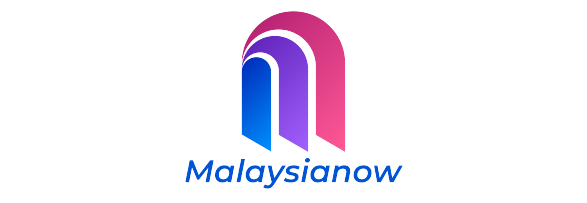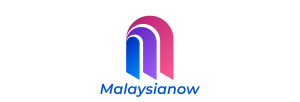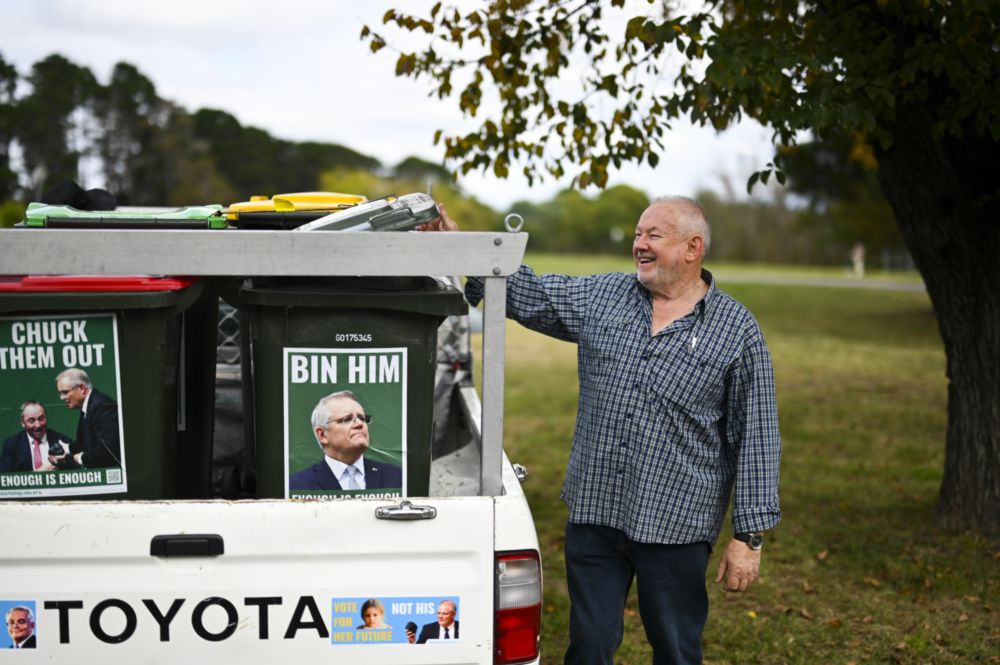A protester is seen waiting for Australian Prime Minister Scott Morrison outside Government House ahead of a likely 21 May election in Canberra, Sunday, April 10, 2022. — AAP Image/Lukas Coch via Reuters
APRIL 10 — The government enters the battle trailing the opposition 46-54 per cent in the latest Newspoll, conducted after the budget, with Morrison and opposition leader Anthony Albanese virtually level as preferred prime minister. Labor is also ahead in the other major polls.
After flying from Sydney, Scott Morrison visited the governor-general this morning, paving the way for a six-week campaign. The Coalition is seeking its fourth term, while Morrison is leading the government into his second election as prime minister.
Labor needs a uniform swing of 2.6 per cent to finish with more seats than the Coalition, on ABC election analyst Antony Green’s pendulum. But it needs a 3.2 per cent swing – and a net seven seats gain – to secure majority government. Swings, however, are seldom uniform.
After the redistribution the government goes into the election with 76 seats in the 151 House of Representatives. (This includes notionally the NSW seat of Hughes, presently held by Craig Kelly who defected to the crossbench.) Labor starts with 69 seats.
All seven lower house crossbenchers, including Kelly, are recontesting, with most (but not Kelly) expected to be returned.
Morrison will have at the centre of his campaign pitch economic management, with the Australian economy coming back strongly after the pandemic and unemployment at 4 per cent and set to fall further. The Coalition is also running hard on national security. A big infrastructure program is aimed at appealing to voters in the regions.
The opposition has the theme of “Labor cares” with major policies on child care and aged care, as well as a suite of policies for the nation to “build back better” after Covid-19.
Both sides will release more policies during the campaign.
Much interest will be in the high profile so-called “teal” independent candidates standing in Liberal-held “leafy” suburbs seats on platforms that highlight climate change and integrity issues. A number of these independents are receiving funds from the well-resourced Climate 200.
The formal campaign is starting off the back of the government’s giveaway budget which contained big ticket items, including a cut in petrol excise for six months, to ease financial pressures on families as the cost of living has escalated as an issue.
The government is defending only five seats with two-party preferred margins under 3 per cent (one of them, Wentworth, against a “teal” independent) compared with Labor’s 12.
There will be a special arrangement for people who contact Covid or find themselves suddenly in isolation as a close contact – for them, there will be a 72-hour window for telephone voting after postal vote applications close.
Seats to watch
Queensland
Lilley (ALP 0.6 per cent); Blair (ALP 1.2 per cent); Longman (LNP 3.3 per cent); Defence minister Peter Dutton’s seat of Dickson (LNP 4.6 per cent); Leichhardt (LNP 4.2 per cent); Griffith (ALP 2.9 per cent); and Brisbane (LNP 4.9 per cent). The Coalition is relying on Queensland to shore up its support.
Western Australia
Cowan (ALP 0.9 per cent); Swan (LIB 3.2 per cent) where MP Steve Irons is retiring; a radically re-drawn Pearce (LIB 5.2 per cent) where former minister Christian Porter is retiring; Minister for Indigenous Australians Ken Wyatt’s seat of Hasluck (5.9 per cent); and Special Minister of State Ben Morton’s seat of Tangney (LIB 9.5 per cent). Labor is hoping for gains in WA.
Tasmania
Bass (LIB 0.4 per cent), and Braddon (LIB 3.1 per cent)
Victoria
Chisholm (LIB 0.5 per cent); Deakin (LIB 4.7 per cent); Casey (LIB 4.6 per cent); La Trobe (LIB 5.1 per cent); Higgins (LIB 2.6 per cent); Indi (IND 1.4 per cent V LIB).
New South Wales
Macquarie (ALP 0.2 per cent); Greenway (ALP 2.8 per cent); Parramatta (ALP 3.5 per cent); Dobell (ALP 1.5 per cent); Eden-Monaro (ALP 0.8 per cent); Gilmore (ALP 2.6 per cent);
Reid (LIB 3.2 per cent); Banks (LIB 6.3 per cent); Robertson (LIB 4.2 per cent); Lindsay (LIB 5.0 per cent); Wentworth (LIB 1.3 per cent v IND). The parties are expecting seats to go both ways in NSW.
South Australia
Boothby (LIB 1.4 per cent).
Northern Territory
Solomon (ALP 3.1 per cent); Lingiari (ALP 5.5 per cent).
As at December 31 2021, 17,032,907 Australians were enrolled to vote. — Reuters
Source: The ConversationDisclaimer: This asset – including all text, audio and imagery – is provided by The Conversation. Reuters does not guarantee the accuracy of, or endorse any views or opinions expressed in, this asset.



